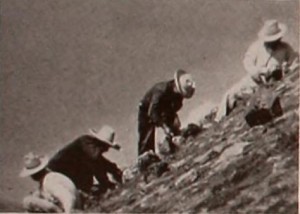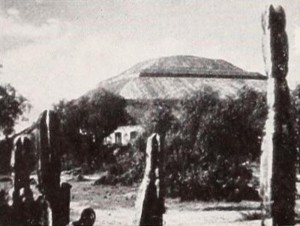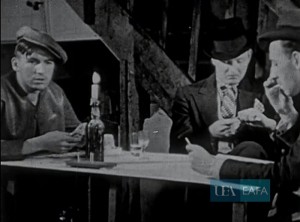
"The immaculate camera work, incisive editing and attractive titling of Frank E. Gunnell have flowered into a new and superior beauty in Down Mexico Way. Here, in two full reels which seem like less, are all the standard Mexican Meccas — the capital city, the pyramids of Teotihuacan, Cuernavaca and the rest — each suavely sequenced and beautifully filmed. Added to these is a wealth of human interest, in smoothly planned records of such odd Mexican folklore as the self threaded needle cut from a maguey cactus, or the red dye concealed in the silvery cochineal wood louse. Mr. Gunnell's most superb triumphs, however, are in his moody and magnificent studies of Xochimilco and Taxco, Mexican communities which have beckoned to countless movie makers, but which only a few have answered with genuine eloquence and distinction." Movie Makers, Dec. 1941, 563-564.

"Down Mexico Way, by Lester F. Shaal. is a pleasing combination of travel, education and simple, stirring beauty. Beginning at the Providence (R. I.) railway station (the producer's home city), the film takes us swiftly by train to Mexico, D. F., the country's capital. After a tour of that metropolis, one visits in turn such popular tourist meccas as Xochimilco, San Juan Teotihuacan, Cuernavaca, Toluca, Taxco and others. An attractive map of Mexico, in color, introduces these several journeys and makes clear the geographical relations of the different towns. Mr. Shaal's camera work is tripod steady throughout, his compositions are pleasing and his musical scoring is an effective supplement. Of outstanding beauty are his sequences on golden, sunny Taxco and of the ancient, so often cloud shrouded, twin volcanos." Movie Makers, Dec. 1944, 495-496.
"Clyde Hammond, of 65 Murdock Street, Youngstown, Ohio, won an honorable mention in the 16 millimeter division for his study of country life, 'The Dragon Fly.'Mr. Hammond worked out a strong atmospheric study of a selfish country boy, home from college, and his hard-working farmer father."Photoplay, Jun. 1928, 137
"Artist Dewey Albinson tours an old farm and helps viewers see it in terms of the unusual shapes, interesting colors and rough textures that make strong compositions." Minnesota Historical Society.
"The special award, also of $500, went to Kennin Hamilton, of 28 Maitland Street, Toronto, Ontario, Canada, for his visualization of Hood's 'The Dream of Eugene Aram' in 16 millimeters. Mr. Hamilton played the principal role of Eugene Aram, disclosing a graceful pantomimic skill. The photography was handled by K. A. Mackenzie. A Cine Kodak, using Kodak Safety Film, was used. Mr. Hamilton had no special lenses or equipment and yet he achieved some singularly beautiful shots. Nature supplied his lighting, even for his interiors. A stepplader served as a tripod." Photoplay, Jun. 1928, 136.
"Children get dressed after swimming with help from their mother; later they are seen larking around in the garden, tying their father up with a rope." (NWFA Online Database)
"Drifting, a two reel photoplay produced under the direction of Jack Navin, ACL, is an old school melodrama, planned, played and directed to ring the last harsh change on the "wages of sin" motif. It is distinguished by consistently dramatic lighting, a smoothly sequenced filming plan and a definitely mature understanding of cinematic treatment. In it a large cast plays well and with a thorough seriousness that adds much charm to the original melodramatic conception." Movie Makers, Dec. 1932, 561.
"Another melodrama, delightful in its serious characterizations and adroit in its cutting and camera treatment, has been completed under the direction of Jack Navin, ACL, producer of Sophistication and Those Mad Barclays. The new work is Drifting, a direct descendant in the Navin tradition, as it tells a tale of the relentless downfall of too, too pretty Ellen Rowen in vain search of her kidnapped little brother. Once the toast of Paris, in the end a drab of Montreal slums, Ellen drifts inevitably to a harsh fate, protesting bitterly on her pathway that she "was once a lady." Elizabeth Sutherland played Ellen with " a defensive delicacy that was touching. Other parts were ably carried by Virginia Simmons, Margaret Newnan, Gretchen Rickel, Mary Reynolds, Nellie Navin, Martha Blodgett, Coman Munroe, Junie Newnan, Ted Newnan, Bobby Sutherland, Fred Griffiths, Bill Laurie, Thayer Hutchinson, Bob Drysdale, John Hutchinson, Edward Mackenzie, Bill Newnan, the Blodgetts and Mr. Navin."
Movie Makers, Dec. 1932, 575, 577.
"The film is credited to Evelyn, who captures her husband’s collecting habits of “everything and anything.” This time it happens to be driftwood. Title cards of dialogue are interspersed with images of John and Evelyn collecting driftwood along a Wisconsin beach." Chicago Film Archives

"A tale of greed, murder and passion set in a French provincial town in the 1930s. The focus is a tawdry basement drinking and gambling club. Rejecting the violent advances of a man who returns to her rooms with her, a local girl kills him and is assisted in the disposal of the corpse by her regular beau - a cynical, louche cardsharp. A vigilant detective brings her to court for murder. Witnesses take the chance to blacken her name by giving false testimonies but she is acquitted. Her freedom is soured by her lover's rejection of her and she returns to the streets" East Anglian Film Archive.
Total Pages: 299